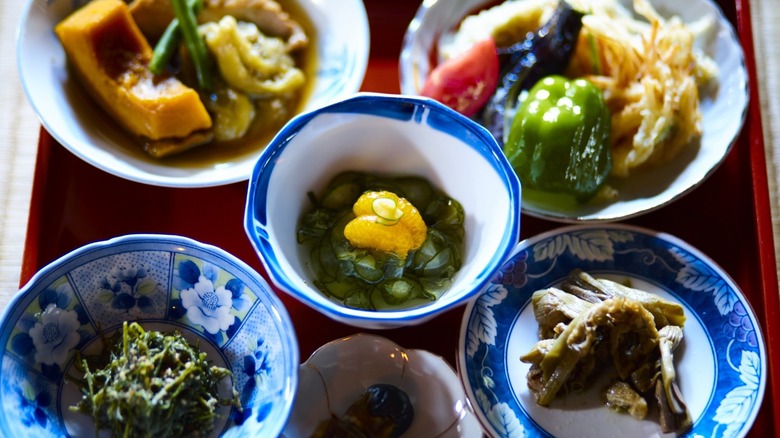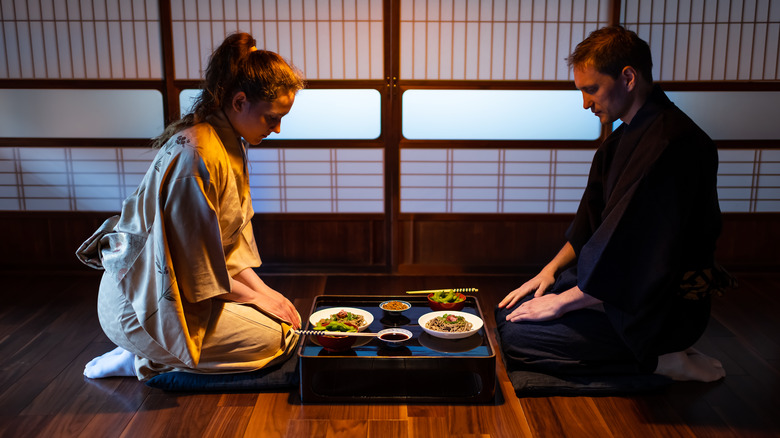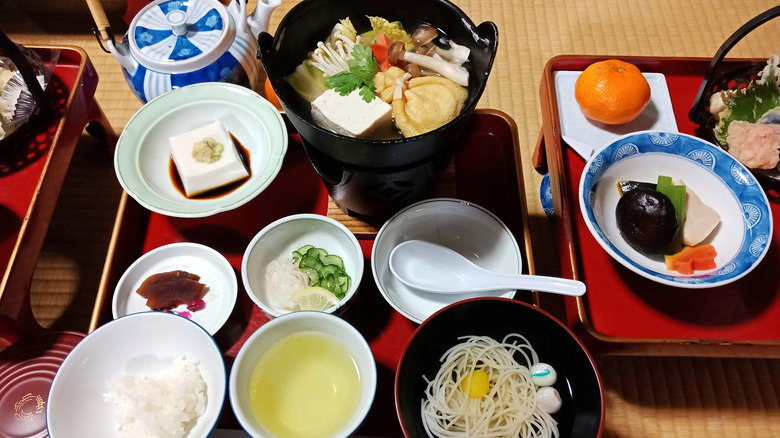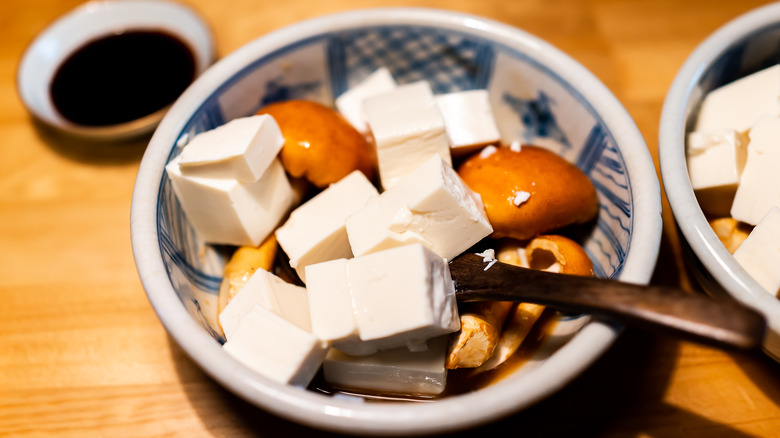Everything You Need To Know About Buddhist Cuisine Shojin Ryori
While the rest of the world cooks to eat, cooks for pleasures of the tongue, or considers cooking a pesky chore to keep one's body functioning, somewhere else in the world cooking is considered to have the power to align the body, mind, and soul. Such is the power that the Buddhist cuisine of Shojin Ryori is considered to have and so, it is often aptly referred to as being "devotion cuisine" (via BBC).
Shojin Ryori came to Japan through China along with Zen Buddhism in the 13th Century (via Savor Japan). A Japanese monk Dogen founded Zen Buddhism and along with it, introduced Shojin Ryori to the country. As a result, the Buddhist cuisine Shojin Ryori is based on the principles of Zen Buddhism. According to Matcha, the cuisine follows the principles of soshoku, followed by Buddhist monks, which means to eat only what is needed for the human body to survive. This is why Shojin Royri is a vegetarian cuisine that forbids not just the use of any meat or seafood, but also doesn't use pungent root vegetables such as onion and garlic.
While the principles of Shojin Ryori may make the cuisine seem like it is plain, bland, and meant only for its nutritional value, there's a lot more to the cuisine than meets the eye — including tons of flavor.
Shojin Ryrori chefs must become one with their ingredients
Primarily a cuisine of Buddhist monks, Shojin Ryori is made of several small dishes that are mostly cooked and eaten at Buddhist temples in Japan and stresses on mindful and spiritual cooking. According to monk Dogen, Shojin Ryori requires the chef to be mindful and focused as the cooking process can be tedious and repetitive (via BBC). The cooking requires hours of hard work for a relatively short-term reward of eating a small dish, all of which is supposed to test the chef's expectations, and at the same time, manage their ego.
Shojin Ryori also requires that chefs become one with their ingredients. In order to reach this spiritual stage of mind, the chefs must carefully hone the three minds of Zen Buddhism. These include aishin — a state of calm — and roshin — to respect the ingredients in use as well as the diner — as well as kishin — to cook with gratitude and joy.
Culture Trip reports that in certain temples, chefs can't waste or discard any ingredients including bruised parts of any produce, adding to the state of oneness with the ingredients and the mindfulness of Shojin Ryori chefs.
Shojin Ryori employs the rule of five
The number five has a lot of significance in Buddhism, which consequently reflects in Shojin Ryori as well. Per BBC, the number five — according to the Chinese philosophy of wuxing — represents the balance and harmony between the society and mother earth. Similarly, five has a lot of significance in Shojin Ryori. The many little dishes that make up a Shojin Ryori meal must use five colors: black, white, yellow, green, and red. The meal should incorporate elements cooked through five different methods of cooking: simmered foods, fried foods, grilled foods, steamed foods, and finally, raw foods. Then, a Shojin Ryori meal must have five flavors: sweet, salty, bitter, sour, and umami. Together, the meal then appeases the five human senses: sight, smell, touch, taste, and sound.
Not only is Shojin Ryori a feast of colors, then, but it also has tons of different textures and flavors. The rule of five philosophically grounds Shojin Ryori in Buddhism and is thought to make the meal of complete nutritional balance for a human body, in line with changing seasons as well (via Savor Japan).
Shojin Ryori ingredients and dishes
Considering Shojin Ryori is Buddhist cuisine, there are certainly no meats, seafood, or root vegetables that appear in its cooking. According to Savor Japan, soy-based items like tofu, dried tofu, fermented soybeans, and fried soybean curds are popular Shojin Ryori ingredients. Yuba (tofu skin), fu (wheat gluten), nori (dried seaweed), soy sauce, dashi, and miso are other common items (via Journy). Along with the staples, an essential part of Shojin Ryori is the use of fresh seasonal produce. Depending on the season, chefs may use tomatoes in the summer, squash in autumn, and certain root vegetables in the winter — except onion and garlic, of course.
A typical Shojin Royri meal, following the rule of five, is made of several small dishes. Per Savor Japan, the meal usually follows the principle of "one soup, three sides" along with the accompaniment of rice and pickles. Soups may include clear broth-like liquids with vegetables or creamy carrot or pumpkin soups. As for sides, there are several preparations of tofu that can be served, along with salads and tempura.
While Shojin Ryori is typically cooked by Buddhist monks in temples, the cuisine has also started appearing in restaurants across Tokyo (per Inside Kyoto). So, if you happen to be planning a trip to Japan any time soon, it's definitely worth trying.



